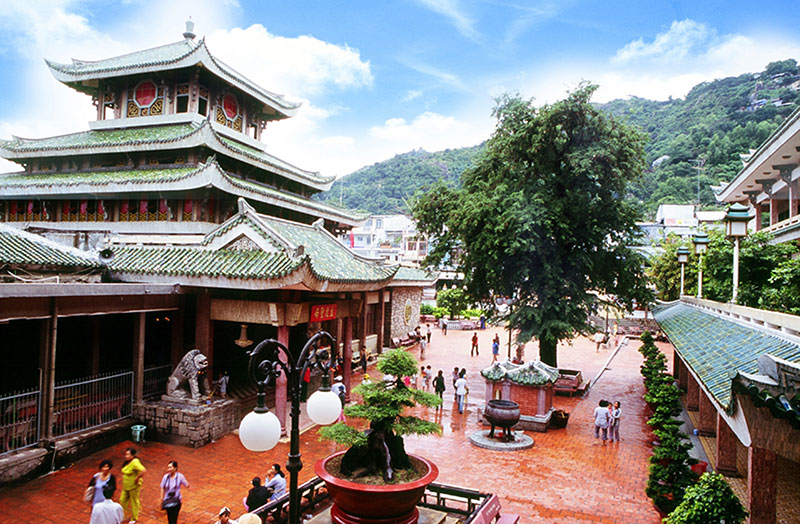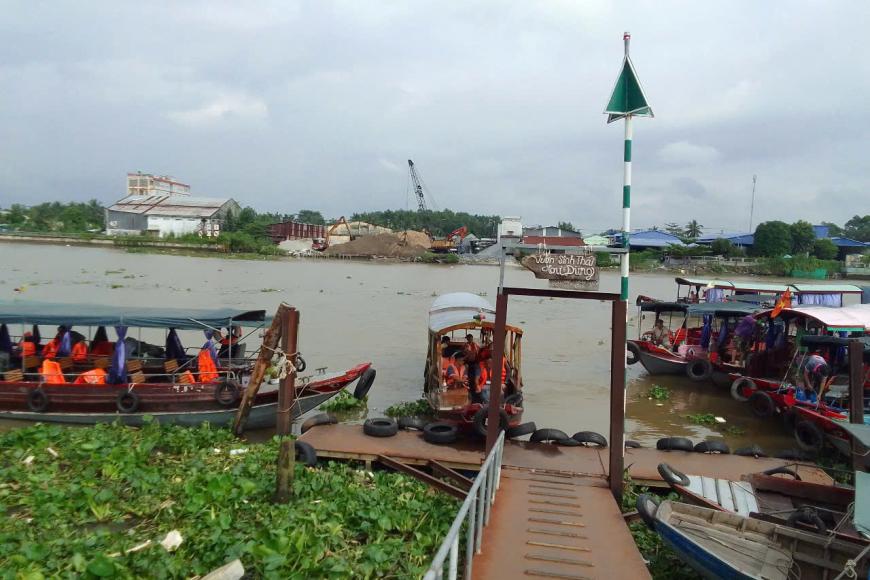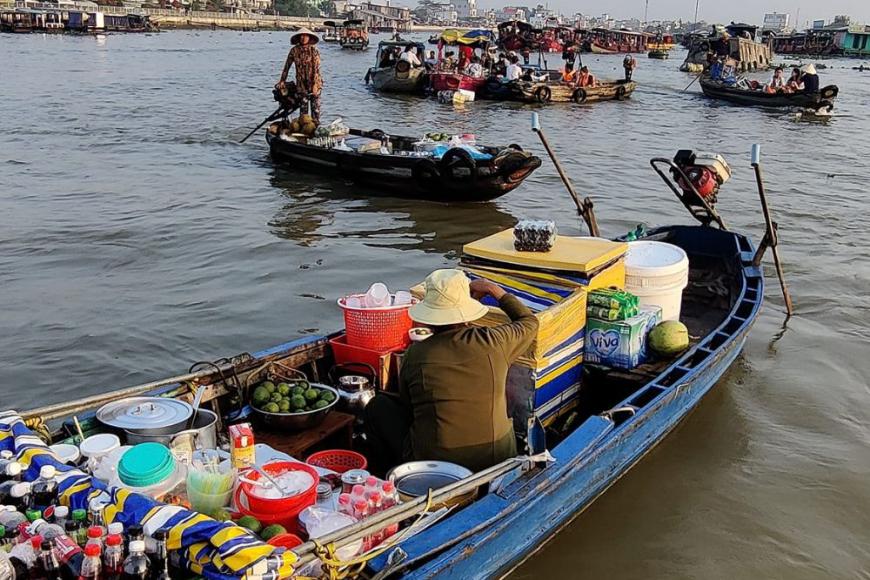- Nha Trang Travel Information
- Muine Travel Information
- Hue Travel information
- Cantho travel information
- Sapa travel information
- Ha Giang Travel Guide
- Ninh Binh Travel Information
- Quy Nhon Travel Information
- Vietnam Travel Information
- Hoian Travel Guide
- Vung Tau Travel Information
- Quang Binh Travel Information
- Phu Quoc Travel Information
- Ha Tinh Information
- Ca Mau information
- Quang Ninh Travel Information
- Tay Ninh Travel information
- Hoian travel guide
- Tien Giang travel guide
- Con Dao Travel information
- Ninh Thuan information
- Moc Chau information
- Danang Vietnam Travel Information
- Hanoi Travel Information
- Ho Chi Minh Travel Information
- Dalat Travel Information
CHAU DOC TOWN – THE PEACEFUL TOWN IN MEKONG DELTA
CHAU DOC TOWN – THE PEACEFUL TOWN IN MEKONG DELTA

Chau Doc - home of many Kinh (Vietnam’s ethnic majority), Khmer, Cham and Chinese people is only a few kilometers from the Cambodian border and located on the Hau diffluence (Bassac River). There is lively boat traffic on the river and also an impressive floating market. The street market is worth a visit too. One of the pleasures of visiting Chau Doc is simply walking around; the river bank is a popular spot. Locals are a little shy but may talk to you as you walk. Chau Doc may be a little city, but what it lacks in size it makes up for in colours and is probably the only place where pastel colours are chosen to beautify store fronts.
History of Chau Doc
The site of Chau Doc was long in history a territory of the Kingdom of Funan.General Nguyen Huu Canh (1650-1700), who served under Lord Nguyen Phuc Chu, certainly contributed to the establishment of Chau Doc as it is today. His troops built whole communities and villages. The territory became Vietnam’s around the 17th century. In 1815, King Gia Long of the Nguyen Dynasty ordered the construction of Chau Doc Fort on the western bank of Chau Doc river. A Chinese mandarin named Diep Hoi was assigned as head of Chau Doc and he went about trying to tempt farmers and artisans to settle and work on these wild, wet lands. To encourage settlers the King's government would grant loans for immigrants to reclaim land or set up businesses. today, Chau Doc is close to the river border of Vietnam and Cambodia. Anyone who travels to and from Phnom Penh by boat will pass by the city, and staying overnight is highly recommended. Aside from the colours, visitors will also captivated by the locals; the people in Chau Doc, including the xe dap loi drivers, are nice and friendly. Foreigners need not worry too much about a language barrier—English is spoken in most hotels and guesthouses.
Main attractions in Chau Doc
- Sam Mountain – the highest mountain in Mekong Delta, located in the west of Chau Doc Town. This 230m high mountain is also one of the most beautiful landscapes in Vietnam with endless gold rice fields. On top of the mountain, you can have a really good view of the surrounding countryside and easily look out over Cambodia – a neighboring country of Vietnam.
- Chau Doc floating market is another famous market in the Mekong Delta and one of the well-known attractions of An Giang Province. You can see that the life of locals here depends mostly on boats. Most of the activities of exchange and sales are in this floating market. Merchants from different places in Vietnam carry products to Chau Doc and sell them to the locals and tourists.
- Tra Su Cajuput Forest. This forest has a lot of potentials to develop ecotourism, outdoor activities, and exploration as well as giving scientists a chance to learn and research the local environment and typical ecological system of the southern region. In the floating season, going by boat into the forest, you will feel relaxed as you are walking in the middle of a green grass on the water. This immense 800,000-hectare forest is home to an astounding number of wading birds. Much of the wetland is off-limits to visitors so that the birds' breeding grounds are not disturbed, but visits include a short speedboat ride and a tranquil 20-minute paddle along narrow channels through the gnarled and green sunken forest. Even if you only spot a few birds, it's a beautiful, if short, green trip. The sanctuary is 23km west of Chau Doc.
- Cham Minority village. The Cham religion of the coastal Cham is influenced by Hinduism. Beside The Cham people around Chau Doc, represent the mixture between a rustic form of Sunni Islam, due to being come by seafaring Muslim traders in the late 10th and early 11th centuries and emigrated of Muslim Chams from Cambodia to the Mekong Delta in the mid-19th century. Chau Doc is home to diverse ethnic and religious communities where Cambodian Buddhists, Vietnamese Buddhists, ethnic Chinese and Muslim Cham living peacefully side by side.
- The Lady Temple - The Ba Chua Xu Temple. Located at the foot of Sam Mountain – the main attraction in Chau Doc. The temple was established at the beginning of the 19th century in Vinh Te Hamlet, Chau Doc Town. At first, the temple was made of bamboo. In 1962, it was roofed with double tiles. Then in 1972, it was rebuilt (except the 10 meter-long stone wall at the back, which was the old platform of the tower). The monument was completed in 1976. Ba Chua Xu Temple Festival is held from 23 to 27 of the 4th lunar month. Thousands of pilgrims come to the festival to attend to offer flowers, and to pray for health and luckiness.
other
Cai Rang floating market, Cantho is the well-known destination in Mekong Delta and into the top 19+ must-to visit in Southeast Asian flowing British travel publication Rough Guides. This market is trading on waterways and has become a unique signature for generations.
In the Mekong Delta region of Vietnam, Can Tho is a significant business and transportation hub and a popular destination for local and international tourists. In addition to being referred to as "a river delta city," Can Tho is well-known for its waterways' lyrical beauty, the culture of great value, and the distinctive cuisine served there. If you are looking for a place to get away from the hustle and bustle of the city and spend some time in the great outdoors, Can Tho is the ideal destination for you. Even though there are many things to do in Can Tho, the following is a handpicked list of the top 10 activities you should add to your list of things to do.
Phu Quoc wants vaccination speeded up to get tourists back.
In recent years, Nam Du island has become one of the top destinations for a quick weekend escape trip for many local youngsters. Even though the island is much smaller compared to Phu Quoc island, it’s way cheaper.
Nam Du wins the hearts of many people because of its pristine beach, gorgeous small green islets surrounding the main island, delicious seafood, and interesting island-hopping tours. This article will cover all the facts that you need to know before traveling to this beautiful island.








